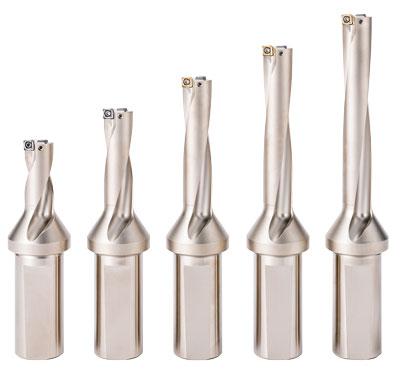
Kyocera announced that it has developed a new line of indexable modular drills, Magic Drill DRV, to be used mainly for hole drilling in the machine tool business. Ideally suited for the automobile, aviation and medical device industries, the new indexable drills combine a chemical vapor deposition (CVD) coated insert on the outer edge and a physical vapor deposition (PVD) coated insert on the inner edge for the first time, enabling high-speed and high-efficiency processing.
The uniquely developed chipbreakers have improved chip evacuation and the holder’s thicker center core provides enhanced rigidity. Consequently, the new drill is now capable of deep drilling up to 6D (six times the holder diameter) for the first time. Kyocera aims to contribute to its customers’ increased productivity by broadening its product lineup to meet more diversified needs.
Reduced weight and greater functionality of components are currently being promoted in the automobile, aviation and medical device industries. This trend increases the demand for products that enable high-speed and high-efficiency drilling of various workpiece materials under diversified drilling conditions. With previous indexable drills, PVD-coated chipbreakers were adopted for both the outer and inner edges, which has the disadvantage of increased wear and tear on the outer edge because it comes into contact with the workpiece material at a higher speed. To solve the problem, this new model adopts a CVD-coated chipbreaker with heat and wear resistance for the outer edge and a PVD-coated chipbreaker for the inner edge so that stable processing can be achieved even if a strong force is applied to the inner edge. In this manner, by making use of the features of both CVD and PVD coatings, high-speed and high-efficiency processing become feasible.
With an optimal chipbreaker selected from the four types available, the Magic Drill DRV series is capable of working with a variety of workpiece materials. The chipbreakers are designed so that four corners (edges) can be used, thereby reducing the customer’s processing costs.
The outer edge has a “U-shaped” design to evacuate drilled chips easily and prevent the chips from clogging; and the inner edge has a “spoon-shaped” design to reduce frictional resistance during evacuation of drilled chips, thus enabling excellent evacuation of drilled chips. With this design, it becomes possible to form the flute (groove) into an optimum shape and increase thickness of the holder center core by approximately 33 percent compared with competitors’ products. Through the achievement of high rigidity and low resistance, the new model is capable of drilling a deep hole up to 6D, which has never been possible with a conventional indexable drill.
Contact Details
Related Glossary Terms
- chemical vapor deposition ( CVD)
chemical vapor deposition ( CVD)
High-temperature (1,000° C or higher), atmosphere-controlled process in which a chemical reaction is induced for the purpose of depositing a coating 2µm to 12µm thick on a tool’s surface. See coated tools; PVD, physical vapor deposition.
- chemical vapor deposition ( CVD)2
chemical vapor deposition ( CVD)
High-temperature (1,000° C or higher), atmosphere-controlled process in which a chemical reaction is induced for the purpose of depositing a coating 2µm to 12µm thick on a tool’s surface. See coated tools; PVD, physical vapor deposition.
- chipbreaker
chipbreaker
Groove or other tool geometry that breaks chips into small fragments as they come off the workpiece. Designed to prevent chips from becoming so long that they are difficult to control, catch in turning parts and cause safety problems.
- physical vapor deposition ( PVD)
physical vapor deposition ( PVD)
Tool-coating process performed at low temperature (500° C), compared to chemical vapor deposition (1,000° C). Employs electric field to generate necessary heat for depositing coating on a tool’s surface. See CVD, chemical vapor deposition.
- physical vapor deposition ( PVD)2
physical vapor deposition ( PVD)
Tool-coating process performed at low temperature (500° C), compared to chemical vapor deposition (1,000° C). Employs electric field to generate necessary heat for depositing coating on a tool’s surface. See CVD, chemical vapor deposition.
- wear resistance
wear resistance
Ability of the tool to withstand stresses that cause it to wear during cutting; an attribute linked to alloy composition, base material, thermal conditions, type of tooling and operation and other variables.
